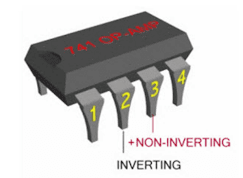What Is an Op-Amp?
An Op-Amp stands for an operational
amplifier is defined as a multistage amplifier in which a number of amplifier
stages are interconnected to each other. In other words, the Op-Amp is
basically a voltage amplifier with a high voltage gain. The term Op-Amp or
operational amplifier was first used by John R. Ragazzini in the year of 1947.
An Op-Amp can be used to perform a
variety of operations like addition, subtraction, differentiation, integration,
and amplification.
The popular Op-Amp IC is 741 Op-Amp IC. The typical gain of a 741 Op-Amp is 2 * 105 or 106 dB.
Symbol and Terminal of 741 Op-Amp
The physical appearance and the circuit symbol of a 741 Op-Amp are shown in the below figure.
 |
| Physical Appearance |
As shown in the above figure, an Op-Amp has two input terminals, one output terminal, and two supply voltage terminals.
Input of an Op-Amp
An Op-Amp has two input terminals, one input is called inverting input which is marked as a negative sign (-) and the second input is called non-inverting input which is marked as a positive sign (+). We can apply the input voltage which is to be amplified to any one of the above inputs and another pin is connected to the ground.
If we connect the input signal to the inverting terminals then we get the amplified output signal which is 1800 out of phase with the input signal. Hence, it is known as an inverting input. Similarly, if we connect the input signal to the non-inverting terminals then we get the amplified output signal which is in phase with the input signal. Hence, it is known as a non-inverting input. It is shown in the below figure.

Input and Output Signal with 1800 Inverted Output and Non-Inverted Output When Input Signal is Applied to the Inverting and Non-Inverting Terminal of an Op-Amp
DC Power Supply for an Op-Amp

| Input and Output Signal with 1800 Inverted Output and Non-Inverted Output When Input Signal is Applied to the Inverting and Non-Inverting Terminal of an Op-Amp |
The dual polarity power supply is necessary for the operation of an Op-Amp. Here, the +VCC and -VEE are the power supply terminals of the Op-Amp. The +VCC terminals of an Op-Amp are connected to the positive terminal of the one source and the -VEE terminal of an Op-Amp is connected to the other source as sown in the below figure.
The Op-Amp 741 IC needs a dual polarity power supply as shown in the figure. However, there are some other Op-Amps that can operate on a single polarity supply.





No comments:
Post a Comment